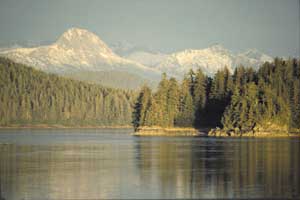|
Bush administration, Congress increase logging on national forests
By Tom Valtin
In the past six months, the Bush administration has turned forest regulations already heavily tilted toward logging and roadbuilding into a timber industry bonanza.

Barbara Boyle |
First, on Thanksgiving Eve, the Bush administration proposed a massive re-write of national forest management regulations that would reduce wildlife protections, citizen involvement, and agency accountability. Then in February, Congress passed a budget rider allowing increased logging in all national forests and Bureau of Land Management (BLM) lands under the guise of "stewardship." Later in the month, the Forest Service denied wilderness protections for 9 million acres in Alaska's Tongass National Forest.
In March, the agency announced plans to more than double allowable logging in the national forests of California's Sierra Nevada. Meanwhile, a restoration plan hailed as a model of cooperation in Montana's Bitterroot National Forest was distorted into little more than an excuse to cut down trees.

Undeserving? The Forest Service recently denied wilderness protections for 9 million acres of the Tongass, the nation's largest national forest. The agency is now considering exempting the forest from the roadless protection rule, clearing the way for dozens of major logging projects.
|
Most of these blows have been struck without public debate-through rule changes, last-minute budget riders, or closed-door conference meetings. Where there has been heavy public input, like the Tongass, the public's wishes have been ignored.
"Ninety percent of Alaskans who testified at hearings and provided written comment on the Tongass asked for more wilderness protection," says Betsy Goll, organizer for the Club's National Forest Campaign in Alaska, "and that's not even to mention the 170,000 people nationwide who supported a wild Tongass. The Forest Service's zero-wilderness decision tells the public that clearcut logging, roadbuilding, and the lobbying powers of the timber industry take precedence over tourism, recreation, subsistence, and the region's incomparable fish and wildlife. It's a stab in the back to Alaskans and others who value the National Forest System."
Unfortunately, there is little Americans can do to challenge the Tongass decision. Another rider attached to the February budget bill by Alaska Senator Ted Stevens (R) prohibits the public from seeking administrative appeal or judicial review of the Tongass decision.
"The American people have already spoken in favor of protecting these special places," says Club Legislative Director Debbie Sease, "and sneaky maneuvering by a few in Congress should not forever change that."
Two years ago, President Clinton administratively protected roadless areas of Alaska's Tongass and Chugach national forests, as well as wild forest areas in 37 other states, when he signed the Roadless Area Conservation Rule. But the Forest Service's new measures exempt the Tongass from roadless protections. Goll says the Club's top concern in Alaska is preventing the Bush administration from reversing or undermining the roadless rule. "Right now the rule is hanging by a thread," she says, "and it's the only thing that's protecting these lands."
In California, changes in Forest Service policy would shatter the Sierra Nevada Framework, a management plan in 11 national forests across the state's signature mountain range. Under the framework, approved in late 2000, the Forest Service is allowed to harvest an average of about 150 million board feet of timber per year for the next decade. The Bush plan would allow an average of 450 million board feet to be cut each year during that span. The new policy would also undermine wildlife protections and open old-growth forests to intensive logging.
"The Sierra Nevada Framework protects old-growth areas and emphasizes the urban/forest interface in reducing fire hazard," says Barbara Boyle of the Club's Sacramento office. "The Club worked very hard to get this framework established; it took over a decade to put it together. We helped found the Sierra Nevada Forest Protection Campaign, we conducted letter-writing and postcard drives that resulted in more than 35,000 letters and cards being entered into the public record, we shored up support from members of Congress, we held rallies, we put editorials in newspapers. And what we ended up with was the most comprehensive plan for any national forest in the country."
But as soon as Bush took office, says Boyle, the administration began a million-dollar review of "difficulties implementing the framework," which resulted in the new policy.
The administration also plans to increase logging in Giant Sequoia National Monument, established during the Clinton administration. "In the 1980s, the Forest Service decided to clear-cut all the other species around the giant sequoias," Boyle explains, "which led the Sierra Club to take up a decade-long fight to protect whole ecosystems, not just the giant sequoias." Boyle credits Club activists Carla Cloer and Joe Fontaine with spearheading the drive to establish the national monument.
Boyle calls the Forest Service's new preferred alternative "a complete travesty, the worst environmental impact statement I've seen in my life, and not legally defensible."
Meanwhile, in Montana's Bitterroot National Forest, a forest plan with an emphasis on restoration has unravelled. One year after representatives from the Forest Service, timber industry, and conservation groups signed the "Burned Area Recovery Plan," 70 percent of the allowed logging has been completed compared to less than 3 percent of the restoration.
"The most important thing to me is getting on with the restoration work," said U.S. Forest Service Chief Dale Bosworth the month before the plan was inked. But according to the Forest Service's own figures, in the first year, only one-third mile of the 16 miles of scheduled stream restoration has been completed, and only one-half mile of the 45 miles of roads slated for "obliteration" has been removed. Less than one-eighth of the 33,150 acres proposed for reforestation has been reforested.
In the meantime, $25 million earmarked for forest rehabilitation in the Bitterroot was siphoned off to last year's fire fighting effort. (Surprise: No funds were diverted from the timber sale budget.) Remarking on the resulting fiscal shortfall, a Forest Service official put it bluntly: "We'll have to re-stack the priorities. You can do the math. Everything isn't going to get done."
Adding insult to injury, the majority of the logging has occurred miles from the nearest communities that were purportedly being protected from wildfire, and the trees being "salvaged" have been mainly large, commercially valuable ones.
"The Forest Service promised over and over again to the people of Montana and the nation to restore the burned areas of the forest," says Sierra Club President Jennifer Ferenstein, a Missoula resident. "They broke that promise."
Under the new measures adopted by Congress in February, it's not only the Tongass, Sierra Nevada, and Bitterroot that could see heavier logging. The new law establishes a grossly misnamed "stewardship" logging program that will allow logging companies to keep trees they harvest in exchange for reducing undergrowth on some 450 million acres of federal land-BLM lands as well as national forests.
The Forest Service and the BLM will be allowed to award an unlimited number of "stewardship contracts," which would essentially pay logging companies in trees for maintaining or thinning forests. Timber industry leaders applauded the move, saying it could allow forest supervisors to improve forest conditions by getting help from the private sector. But environmentalists blasted the plan as a blatant tree grab and a federal subsidy for the timber industry, charging that the new measures will allow commercial interests to design timber sales without proper Forest Service oversight.
Take Action:
Copy and send the letter below, or better yet, write your own letter to:
USDA FS Planning Rule
Content Analysis Team
P.O. Box 8359
Missoula, MT 59807
planning_rule@fs.fed.us
Fax: (406) 329-3556
Protect Our Wild National Forests
Dear Forest Service:
Instead of undermining current national forest and wildlife protections, the Bush administration and the Forest Service should be working to protect our wild roadless forests, stop damaging commercial logging and logging-road construction on public lands, and restore our national forests.
I oppose the Bush administration's proposed changes to National Forest Management (NFMA) regulations. These proposed regulations would weaken environmental and wildlife safeguards, harm wild forests and clean water, drastically limit public involvement, increase damaging commercial logging projects, and reduce agency accountability. Please completely withdraw these harmful proposed NFMA regulations. Please count this as my official comment on these proposed regulations.
Sincerely,
Name
Address
City/State/Zip
Up to Top
|